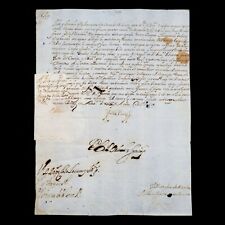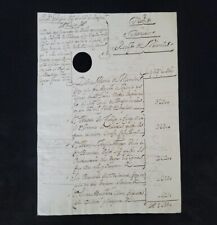|

On eBay Now...
1695 King Charles II Spain Signed Document Royal Manuscript Autograph Royalty ES For Sale

When you click on links to various merchants on this site and make a purchase, this can result in this site earning a commission. Affiliate programs and affiliations include, but are not limited to, the eBay Partner Network.

1695 King Charles II Spain Signed Document Royal Manuscript Autograph Royalty ES:
$699.96
LOT-Y53. For your consideration is a rare and important hand-signed antiqueRoyal 1695 manuscript document / letter / commission / appointment / order /decree / edict by HRH King Charles II of Spain (6 November 1661 – 1 November1700). The subject matter of this rare royalty document isconcerning: CARLOS II, Bartolomé Ordovás, justice, expenses. Letter addressed to D. Francisco de Cardona, of the Order of Montesa, General Dance of Valencia, in which it is indicated that the letter of June 14 has been read to Bartolomé Ordovás, in which the doubts are represented to execute the dispatch of January 31 regarding the form of distribution of the payments consigned in the reception . And it is ordered that the librazas for the expenses of justice, works and expenses be settled as heretofore. Plus autograph signature of Bartolomé Ordovas. Hand-signed autograph “Yo el Rey” (I THE KING) in irongallic ink by King CARLOS II Spain, in Madrid, dated June 24, 1695. Manuscriptlaid-paper document bearing stamped Royal Crown of Carlos II. Qvarto seal. Onethousand six hundred and ninety-two. Plate seal. Measures 210 x 285mm. The condition of this specific document is as pictured inthe 12 images provided. Document has been subject to toning, stains, folds,tears, rips, missing pieces, wormholes, etc. 16th century perioddocument on laid paper (watermarked). See images. Charles II of Spain (6 November 1661 – 1 November 1700),also known as El Hechizado or the Bewitched, was the last Habsburg ruler of theSpanish Empire. He is best remembered for his alleged physical disabilities,and the war that followed his death. Charles suffered ill-health throughout his life; from themoment he became king at the age of four in 1665, the succession was aprominent consideration in European politics. The historian John Langdon-Daviessummarised this as follows: \"Of no man is it more true to say that in hisbeginning was his end; from the day of his birth, they were waiting for hisdeath\". Despite two marriages, he remained childless. When he diedin 1700, his heir was 16-year-old Philip of Anjou, grandson of Louis XIV andhis first wife, Charles\'s elder half-sister, Maria Theresa.[2] However, thesuccession of Charles was less important than the division of his territories,and the failure to resolve that question led to war in 1701. Charles was the only surviving son of Mariana of Austria(1634-1696) and Philip IV of Spain (1605-1665) who was 56 years old at the timeof his son\'s birth. For political reasons, marriages between Spanish andAustrian Habsburgs were common; Philip and Mariana were uncle and niece, makingCharles their great-nephew and first cousin once removed respectively. Alleight of his great-grandparents were descendants of Joanna and Philip I ofCastile. The best-known consequence of such inbreeding is the\'Habsburg jaw\', a physical characteristic shared by many Habsburgs, includingCharles. However, despite what is often claimed, the extent to which thisinbreeding was responsible for his numerous health issues is unclear, anddisputed; Margaret Theresa, his elder sister, did not have the same issues.Based on contemporary accounts of his symptoms, he may have suffered fromcombined pituitary hormone deficiency and distal renal tubular acidosis. If correct, these would be indicative of rare geneticdisorders, possibly caused by inbreeding. However, in the absence of geneticmaterial, they remain speculation; even a 2019 study by the same team on theHabsburg jaw, based on analysis of portraits, could only conclude a geneticlink was \'highly likely\'. Another suggestion is his health problems derivedfrom a herpetic infection shortly after birth, while his autopsy reportindicates hydrocephalus. Regardless of the cause, Charles suffered physicalill-health throughout his life, as well as depression; by the age of six, hehad had measles, chickenpox, rubella and smallpox, each of which was thenpotentially fatal. His Habsburg jaw was so pronounced he spoke and ate onlywith difficulty, and did not learn to talk until the age of four. However, itwas Mariana who insisted he be carried everywhere until he was eight, and leftuneducated, to reduce the \'strain\' on his body and mind. Although prone toillness, contemporaries reported he spent much of his time hunting. In reality, very little is known for certain, and much ofwhat is suggested unproved, or incorrect. One famous example of his allegedmental problems is that he slept with his father\'s body; while true, it wasdone under instructions from Mariana, whose doctors advised this would help himproduce an heir. Reports from his council and foreign ambassadors indicate hismental capacities remained intact. Since Charles was a legal minor when Philip died on 17September 1665, Mariana was appointed Queen Regent by the Council of Castile.While the Spanish Empire, or \'Monarchy\', remained an enormous globalconfederation, its economic supremacy was challenged by the Dutch Republic, andincreasingly England, while Europe was destabilized by French expansion underLouis XIV. Managing these issues was damaged by Mariana\'s power struggle withCharles\'s illegitimate half-brother, John of Austria the Younger. Administrative reforms were complex, since the Kingdom ofSpain was a personal union of the two Crowns of Castile and Aragon, each withvery different political cultures and traditions. As a result, governmentfinances were in perpetual crisis; the Crown declared bankruptcy nine timesbetween 1557 and 1666, including 1647, 1652, 1661 and 1666. However, the 17th century was a period of economic crisisfor many European states, and Spain was not alone in facing these problems.Infighting between those who ruled in Charles\'s name did little to help, but itis debatable how far they or he can be held responsible for long-term trendspredating his reign. The Monarchy proved remarkably resilient, and when Charlesdied, remained largely intact. The system of delegating duties to a personal minister orvalido was established by Philip in 1621, when he appointed the Count-Duke ofOlivares. Mariana followed this precedent, her first choice being her Austrianpersonal confessor, Father Juan Everardo Nithard; modern assessments of hercompetence are often based on reports by contemporaries, who generally believedwomen were incapable of exercising power on their own. The costs of the Portuguese Restoration War, and the War ofDevolution with France, forced the Crown to declare bankruptcy in 1662 and1666, making reductions in expenditure urgent. The 1668 treaties ofAix-la-Chapelle and Lisbon ended the war with France, and accepted Portugueseindependence. John forced Mariana to dismiss Nithard in February 1669, whoreplaced him with Fernando de Valenzuela. The regency was dissolved whenCharles became a legal adult in 1675, then restored in 1677 on the basis of hishealth. The 1672 Franco-Dutch War dragged Spain into another warwith France over the Spanish Netherlands, placing additional strain on theeconomy. When John finally took charge of government in January 1678, his firsttask was ending it; in the 1678 Treaties of Nijmegen, Spain ceded Franche-Comtéand areas of the Spanish Netherlands returned in 1668. Prior to his death inSeptember 1679, he arranged a marriage between Charles, and a 17-year-oldFrench princess, Marie Louise of Orléans; Mariana returned as Queen Regent buther influence was diminished. The 1683-84 War of the Reunions with France was followed in1688 by the Nine Years\' War. Shortly afterwards, Marie Louise died in February1689; based on the description of her symptoms, modern doctors believe herillness was almost certainly appendicitis. In August, Charles married MariaAnna of Neuburg by proxy, the formal wedding taking place in May 1690; afterhis mother died on 16 May 1696, he ruled in his own name, although Maria Annaplayed a significant role due to his ill-health and her control over access toCharles. It was clear Charles\'s health was finally failing andagreeing on a successor became increasingly urgent. The Nine Years\' War showedFrance could not achieve its objectives on its own; the 1697 Treaty of Ryswickwas the result of mutual exhaustion and Louis\'s search for allies inanticipation of a contest over the Spanish throne. Austrian Habsburg EmperorLeopold refused to sign since it left the issue unresolved; he reluctantly didso in October 1697, but viewed it as a pause in hostilities. One of John\'s last acts was arranging Charles\'s marriage in1679 to Marie Louise, eldest daughter of Philippe I, Duke of Orléans. While theFrench ambassador wrote \'...he is so ugly as to cause fear, and looks ill\', itwas considered irrelevant to the political benefits. Marie Louise was blamedfor the failure to produce an heir, while primitive fertility treatments gaveher severe intestinal problems. There has been considerable debate as to whether Charles wasimpotent, and if so, the cause; reports provided by Marie Louise indicate hemay have suffered from premature ejaculation. The suggestion it was the resultof inbreeding has not been proved, while a number of scientific studies disputeany linkage between fertility and consanguinity. After she died in February 1689, Charles married Maria Annaof Neuburg, one of the twelve children of Philip William, Elector Palatine, andsister-in-law to Emperor Leopold. Although partly selected because her familywas famous for its fertility, she proved no more successful in producing anheir than her predecessor. By this stage, Charles was almost certainlyimpotent; his autopsy revealed he had only one atrophied testicle. As the Crown of Spain passed according to cognaticprimogeniture, it was possible for a woman, or the descendant of a woman, toinherit the crown. This enabled Charles\'s sisters Maria Theresa (1638–1683) andMargaret Theresa (1651–1673) to pass their rights to the children of theirmarriages with Louis XIV and Emperor Leopold. To prevent Spain\'s acquisition byFrance, Maria Theresa renounced her inheritance rights; in return, Louis waspromised a dowry of 500,000 gold écus, a huge sum that was never paid. In 1685, Leopold and Margaret\'s daughter Maria Antoniamarried Max Emanuel of Bavaria; she died in 1692, leaving one surviving son,Joseph Ferdinand. In October 1698, France, Britain and the Dutch Republicattempted to impose a diplomatic solution to the Succession on Spain andAustria, by the Treaty of the Hague or First Partition Treaty. This made JosephFerdinand heir to the bulk of the Spanish Monarchy, with France gaining theKingdoms of Naples and Sicily and other concessions in Italy plus the modern Basqueprovince of Gipuzkoa. Leopold\'s younger son Archduke Charles became ruler ofthe Duchy of Milan, a possession considered vital to the security of Austria\'ssouthern border. Unsurprisingly, the Spanish objected to their Empire beingdivided by foreign powers without consultation, and on 14 November 1698,Charles II made Joseph Ferdinand heir to an independent and undivided SpanishMonarchy. Maria Anna was appointed Regent during his minority, an announcementallegedly received by the Spanish councilors in silence. Joseph Ferdinand\'sdeath in 1699 ended these arrangements. It also left Louis XIV\'s eldest son, the Grand Dauphin, heirto the Spanish throne, once again implying union between Spain and France. InMarch 1700, France, Britain and the Dutch agreed an alternative; ArchdukeCharles replaced Joseph Ferdinand, with Spanish possessions in Europe splitbetween France, Savoy and Austria. Charles reacted by altering his will in favorof Archduke Charles, but once again stipulating an undivided and independentSpanish Monarchy. Most of the Spanish nobility disliked the Austrians, andMaria Anna, and viewed a French candidate as more likely to ensure theirindependence. In September 1700, Charles became ill again; by 28 September hewas no longer able to eat, and Portocarrero persuaded him to alter his will in favorof Louis XIV\'s grandson, Philip of Anjou. He died five days before his 39thbirthday on 1 November 1700; Philip was proclaimed King of Spain on 16th, andthe War of the Spanish Succession began in 1701. The autopsy records his body \"did not contain a singledrop of blood; his heart was the size of a peppercorn; his lungs corroded; hisintestines rotten and gangrenous; he had a single testicle, black as coal, andhis head was full of water.\" As suggested previously, these are indicativeof hydrocephalus, a disease often associated with childhood measles, one ofmany illnesses suffered by Charles.


1695 King Charles II Spain Signed Document Royal Manuscript Autograph Royalty ES $699.96

Royalty Spanish King Signed Antique Royal Seal Charles II Spain Letter Document $139.97

Spanish Royalty King Charles II Spain Signed Antique Royal Seal Letter Document $699.96
|